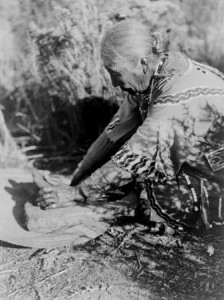Traditional Native American diets depended upon the foods available regionally, with some tribes depending primarily on hunting and others on agriculture. Most foods were minimally processed and fresh, though dried foods certainly played a part in winter provisions. Besides game and fish, Native Americans ate maize (an early type of corn), beans, squash of all kinds, wild rice, sweet potatoes, and tomatoes, cacti, and chilies among other richly nutritious items. Eggs, honey, and many nut varieties rounded out this ancient diet.
Native American diets were extremely low-glycemic (the glycemic index of a food is a measure of how fast its energy is absorbed into the bloodstream) and high fiber. Karl Reinhard, a professor of forensic sciences at the University of Nebraska-Lincoln, says that ancient foods may have been 20-30 times more fibrous than today’s. Native Americans may have actually consumed 200 to 400 grams of fiber a day–an extreme deviation from today’s recommendation of 25 grams of fiber for women and 38 for men and just about impossible to replicate using today’s modified food. Once Native Americans lost their ability to eat traditional foods, they quickly became susceptible to disease and ill health, particularly from diabetes.


